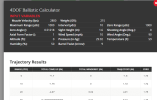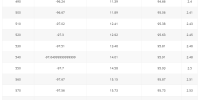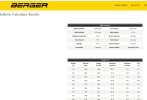You are using an out of date browser. It may not display this or other websites correctly.
You should upgrade or use an alternative browser.
You should upgrade or use an alternative browser.
Where does Rifle cant begin to matter?
- Thread starter jevyod
- Start date
 Help Support Long Range Hunting Forum
Help Support Long Range Hunting Forum
Mostly Tailfeathers
Well-Known Member
Jevyod, Cant is bad, I cant give you any of the science behind it but try not to do it. Do you need a level, I really don't think so, first, in the excitement of shooting at a critter its hard to take your eye out of the scope and check the level. Second I don't find that that little air bubble in liquid is any more accurate than looking at the vertical cross hair and making sure it is straight up and down. Good hunting, MT
For years I never had a level and did pretty well. For ranges past 500 yards I put one on-glad I did. Now I know I am perfect every time, quick and easy. A level will also show you that you aren't as good as you thought you were in all scenarios. I find they do not take any significant time to use once you train with them a little
I would like to point out one thing (which was mentioned in passing by at least one commenter). The important thing is NOT wether you cant your rifle, its wether your RETICLE is plumb or not. I have a friend who cants his rifle quite a bit, every gun of his I pick up (he is a bit of a horsetrader and always has a new gun I'm checking out) when I throw it to my shoulder the crosshairs are noticeably angled, we hold our rifles at LEAST 10 degrees different cant, but he plumbs his reticle to his natural hold when he mounts each scope, as do I. He shoots PRS matches and does pretty well.
You can hold your rifle however, but you MUST hold your reticle level. A level can help with this, personally I prefer a scope mounted one, if you have shot for years like most of us here you have ingrained habits of how you hold your rifle. Rather than try and break those to hold your rifle perfectly plumb, it is a lot easier to shoulder your rifle naturally and plumb the reticles in your scope by turning the scope in the scope rings before tightening down the rings. Then a scope mounted level will insure you hold the same cant to the rifle every time.
If you are out on a hunt and your buddy drops his rifle, you can hand him yours and it may not feel totally natural, but he can look at the level and hold it plumb to shoot accurately. If you shoot a lot in the terrain you are hunting, most of us won't need a level on a gun we have practiced with to shoot 600 yards, the gun will shoulder to pretty much the same place and cant every time. It is when you are really stretching it out there, OR you are using a gun you are unfamiliar with, or was sighted in and/or scope mounted for someone else where you will run into problems and a level will come in really handy.
P.S. I don't have one on many of my rifles, but I've been thinking of putting one on my main hunting long range rifle, I notice my consistency dropping off out past 800, and it would really be good to put one on my wife's rifle as she didn't grow up shooting like most of us and is relatively new at this.
You can hold your rifle however, but you MUST hold your reticle level. A level can help with this, personally I prefer a scope mounted one, if you have shot for years like most of us here you have ingrained habits of how you hold your rifle. Rather than try and break those to hold your rifle perfectly plumb, it is a lot easier to shoulder your rifle naturally and plumb the reticles in your scope by turning the scope in the scope rings before tightening down the rings. Then a scope mounted level will insure you hold the same cant to the rifle every time.
If you are out on a hunt and your buddy drops his rifle, you can hand him yours and it may not feel totally natural, but he can look at the level and hold it plumb to shoot accurately. If you shoot a lot in the terrain you are hunting, most of us won't need a level on a gun we have practiced with to shoot 600 yards, the gun will shoulder to pretty much the same place and cant every time. It is when you are really stretching it out there, OR you are using a gun you are unfamiliar with, or was sighted in and/or scope mounted for someone else where you will run into problems and a level will come in really handy.
P.S. I don't have one on many of my rifles, but I've been thinking of putting one on my main hunting long range rifle, I notice my consistency dropping off out past 800, and it would really be good to put one on my wife's rifle as she didn't grow up shooting like most of us and is relatively new at this.
Well there is cant and there is level. I installed a Vortex level on my 30-06, which is my primary target rifle and found that even a slight cant can send the bullet to places unknown. My normal pull up to shoot position is a full bubble off of level, doesn't sound like much but can cause a flyer when one would think that the round broke perfect, except not quite level. Shooting with a level mounted where it is visible on the scope can reduce your shot group probably not quite by half. I am sure that some of the flyers that people report is due to the rifle not being level. Conversely if someone shoots with the same exact cant each and every shot and has the rifle zeroed for shooting with that cant it won't make difference. Problem is, are we shooting with the same cant each and every time?I have been watching YouTube videos on long range shooting. Primarily Barbour Creek shooting school. They did an episode where they illustrated how much a 10-15 degree cant can affect impact at 1,000 yards. What I am wondering is how much will it affect 500 yards, 400 etc? Is this a linear thing where 500 would be off half as much as 1,000? Main reason for asking is if I do not shoot beyond 600 yards, is a scope level absolutely necessary?
waveslayer
Well-Known Member
That's why you should always run a level on your hunting rigs, especially with all the terrain variations... learned that the hard way in New Zealand on a long bow hunting trip... bubble level can change your life and ensure great hitsWell there is cant and there is level. I installed a Vortex level on my 30-06, which is my primary target rifle and found that even a slight cant can send the bullet to places unknown. My normal pull up to shoot position is a full bubble off of level, doesn't sound like much but can cause a flyer when one would think that the round broke perfect, except not quite level. Shooting with a level mounted where it is visible on the scope can reduce your shot group probably not quite by half. I am sure that some of the flyers that people report is due to the rifle not being level. Conversely if someone shoots with the same exact cant each and every shot and has the rifle zeroed for shooting with that cant it won't make difference. Problem is, are we shooting with the same cant each and every time?
Hugnot
Well-Known Member
More info:
From Accurate Shooter...
My estimator:
A quicky estimator is to multiply the height of trajectory above line of sight by the sine of cant to give offset. Like for a .22-.250 75 ELD, MV 3150 at 600 yards sighted in at that range would have a mid-range trajectory of about 24 inches at 320-330 yards. Then 24 * .052(sin 3 degrees) = 1.24 inches offset. For 5 degrees the offset for same range & ammo would be .087 (sin 5 deg) * 24 = 2.088 inches.
For a .308 W shooting a 168 hpbt at 2550 fps with a 600 zero, the mid-range trajectory would be 38 inches and the 3-degree cant offset would be .052 (sin 3 deg) * 38 = 1.976 ~ 2 inches, enough to miss an X. Speed makes for flatter trajectories.
For a 300 WM with a 200 ELDX at 2800 fps at 1000 yards the mid-range trajectory would be 107 inches or just under 9 feet. The offset for a 3-degree cant would be 107 * .052 = 5.56 inches, more if shooting a .308 with a 178-grain bullet at 1000, 151(12.5 ft) * .052 = 8 inches. 3 degrees is not much and would be easily ignored without a bubble level on the scope.
This is only an estimator. Most of my rodent shooting is at or under 600 yards &having a flat shooting bullet minimizes the cant effect. The .224 75 ELDM at 3150 is an aim forgiving bullet & a cheap round to shoot.
I have seen estimators that multiply the mid-range trajectory by 4 then multiply that by the sine value - this may or may not correct but I think this would give an inflated value, like for a 168 HpBt at 2550 at 600, 3 degree cant, .052*152 (38*4) = 7.9 inches vs 2 inches. I have not seen this.
Having a pocket calculator with trig functions is handy item, like if a rodent is on top of a 100 ft high cliff, 600 yards away, what is the elevation angle. When Hannibal Lector (of nobility) was a little kid he calculated the height of a tower in his family's castle using the tower's shadow & protractor then paced off distance. Good for MOA & MIL Rad solutions & down & uphill shooting also.
From Accurate Shooter...
My estimator:
A quicky estimator is to multiply the height of trajectory above line of sight by the sine of cant to give offset. Like for a .22-.250 75 ELD, MV 3150 at 600 yards sighted in at that range would have a mid-range trajectory of about 24 inches at 320-330 yards. Then 24 * .052(sin 3 degrees) = 1.24 inches offset. For 5 degrees the offset for same range & ammo would be .087 (sin 5 deg) * 24 = 2.088 inches.
For a .308 W shooting a 168 hpbt at 2550 fps with a 600 zero, the mid-range trajectory would be 38 inches and the 3-degree cant offset would be .052 (sin 3 deg) * 38 = 1.976 ~ 2 inches, enough to miss an X. Speed makes for flatter trajectories.
For a 300 WM with a 200 ELDX at 2800 fps at 1000 yards the mid-range trajectory would be 107 inches or just under 9 feet. The offset for a 3-degree cant would be 107 * .052 = 5.56 inches, more if shooting a .308 with a 178-grain bullet at 1000, 151(12.5 ft) * .052 = 8 inches. 3 degrees is not much and would be easily ignored without a bubble level on the scope.
This is only an estimator. Most of my rodent shooting is at or under 600 yards &having a flat shooting bullet minimizes the cant effect. The .224 75 ELDM at 3150 is an aim forgiving bullet & a cheap round to shoot.
I have seen estimators that multiply the mid-range trajectory by 4 then multiply that by the sine value - this may or may not correct but I think this would give an inflated value, like for a 168 HpBt at 2550 at 600, 3 degree cant, .052*152 (38*4) = 7.9 inches vs 2 inches. I have not seen this.
Having a pocket calculator with trig functions is handy item, like if a rodent is on top of a 100 ft high cliff, 600 yards away, what is the elevation angle. When Hannibal Lector (of nobility) was a little kid he calculated the height of a tower in his family's castle using the tower's shadow & protractor then paced off distance. Good for MOA & MIL Rad solutions & down & uphill shooting also.
Last edited:
Frank in the Laurels
Well-Known Member
- Joined
- Jul 15, 2007
- Messages
- 2,054
It only matters to those eye socket shooters on here who claim that at 900 yards...in hunting it doesn't matters diddlysquat when your target area is as big as a beachball...benchrest competition is another story..

Alex Wheeler
Well-Known Member
It is linear. Moa wise. What is actually happening when you cant a scope is your turning elevation into windage. To help picture this, imagine you dial in 20 moa of elevation. Now, cant the rifle at a 45 to the right. You now have 10 moa of elevation and 10 moa of right windage. If you layed the rifle on its side, you would have no elevation and 20 moa of windage. Thats an easy way to picture what is happening.
Hugnot
Well-Known Member
Using the Hornady 4DOF calculator to calculate mid-range trajectory for a 215 Berger at 2,800 fps I came up with:


Just under 96 inches or 8 feet. The sine of 1 degree is .017.
.017(sine 1 deg) * 96 (mid-range trajectory) = 1.6 or slightly less than 2 inches.
This is enough to cause a missed X ring at 1,000 yards. I have seen shooters cant left or right to make tiny wind corrections.
Shooting at a pop can size rodent (2.5 wide gopher) at 600:
24 inches (mid-range trajectory @ 600, 75 ELDM @ 3150) * .017 (sine 1 degree) = .4 inches >> no big deal, but then there might be some wind to deal with. Wait for the rodent to lay flat & shoot at the upwind end. 5-degree cant would be almost one gopher width at 600.
Some guys on this forum shoot golf balls at 1,000 and they would be real deadly on gophers @ 600.
1 (sine 90 deg, rifle resting on left side, bolt up) * 96 (mid-range trajectory) = 96 inches, 8 feet, elevation now windage.
.707 (sine 45 deg) * 96 (mid-range trajectory) = 68 inches, 5.7 feet, rifle cant half way between 90 and 0 deg.
.5 (sine 30 deg) * 96 (mid-range trajectory) = 48 inches, 4 feet, rifle cant 30 degrees
Berger data with same .308 215 gr. @ 2800 is real close. This assumes a 1,000 yard zero as sights would be adjusted to hit at this range. Mid-range trajectory about 93 inches.



Just under 96 inches or 8 feet. The sine of 1 degree is .017.
.017(sine 1 deg) * 96 (mid-range trajectory) = 1.6 or slightly less than 2 inches.
This is enough to cause a missed X ring at 1,000 yards. I have seen shooters cant left or right to make tiny wind corrections.
Shooting at a pop can size rodent (2.5 wide gopher) at 600:
24 inches (mid-range trajectory @ 600, 75 ELDM @ 3150) * .017 (sine 1 degree) = .4 inches >> no big deal, but then there might be some wind to deal with. Wait for the rodent to lay flat & shoot at the upwind end. 5-degree cant would be almost one gopher width at 600.
Some guys on this forum shoot golf balls at 1,000 and they would be real deadly on gophers @ 600.
1 (sine 90 deg, rifle resting on left side, bolt up) * 96 (mid-range trajectory) = 96 inches, 8 feet, elevation now windage.
.707 (sine 45 deg) * 96 (mid-range trajectory) = 68 inches, 5.7 feet, rifle cant half way between 90 and 0 deg.
.5 (sine 30 deg) * 96 (mid-range trajectory) = 48 inches, 4 feet, rifle cant 30 degrees
Berger data with same .308 215 gr. @ 2800 is real close. This assumes a 1,000 yard zero as sights would be adjusted to hit at this range. Mid-range trajectory about 93 inches.

Last edited: